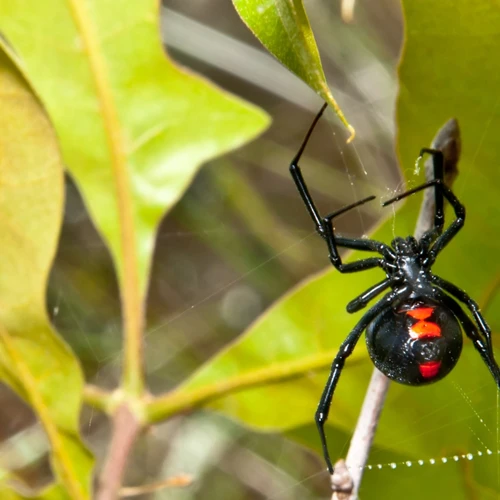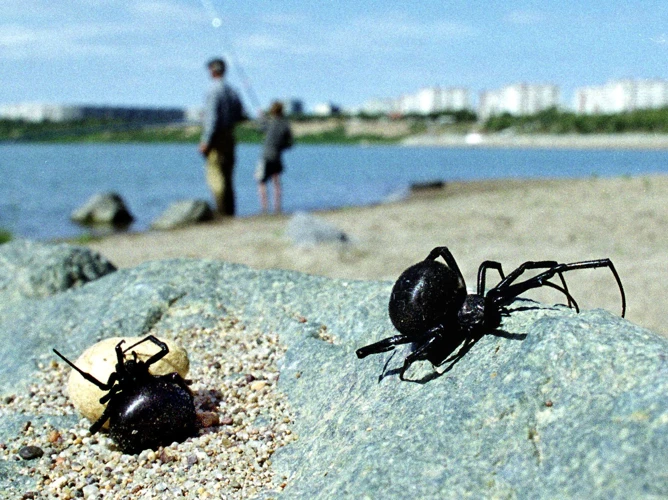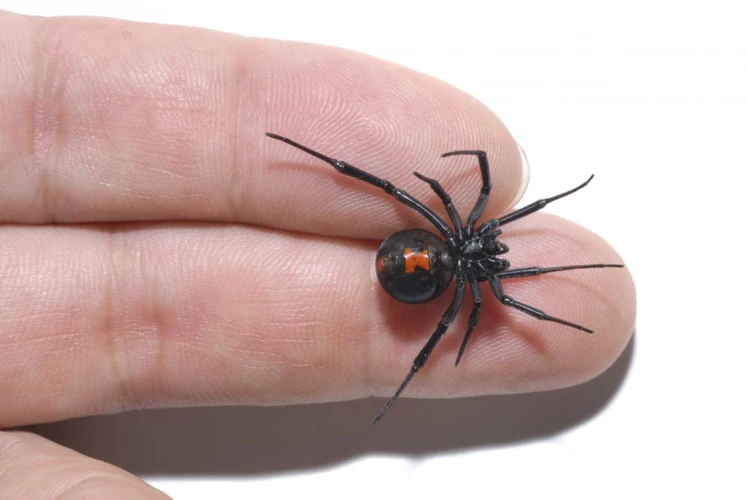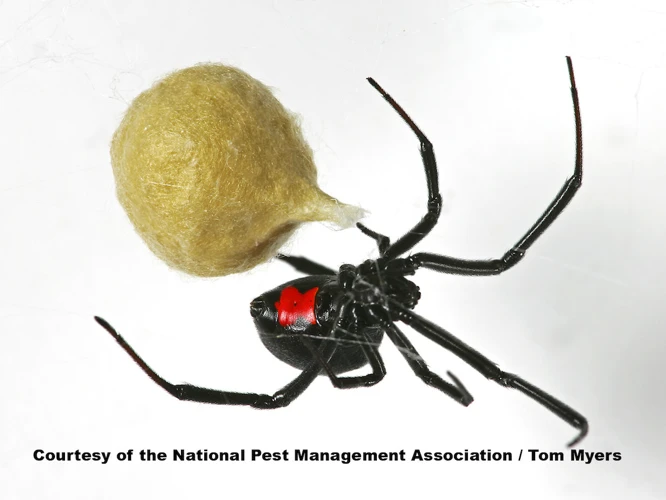As arachnids go, few are as notorious as the black widow spider. Known for its trademark red hourglass marking and poison potent enough to kill a human, this spider is often associated with danger and fear. But just how far-flung are these eight-legged predators? In this article, we’ll delve into the global distribution of black widow spiders and uncover where these fascinating yet intimidating creatures can be found. From the deserts of North America to the tropical climates of Africa and beyond, let’s explore the world of the black widow spider.
What are Black Widow Spiders?

Black widow spiders, a member of the Latrodectus genus, are renowned for their striking coloration and venomous bites. If you’re unfamiliar with this species, you may be wondering what makes them so unique and what risks they pose to humans and other animals. Understanding the appearance, behavior, and distribution of black widow spiders can help you stay safe from their bites and prevent dangerous encounters. Let’s take a closer look at these fascinating creatures.
Appearance and Characteristics
Black Widow spiders are notorious for their distinct appearance and characteristics. They have a black, shiny body with a distinctive fiery-red hourglass shape on their underside. Female black widows are larger than the males and can measure up to 1.5 inches in length, while males are about half the size of females.
Their venomous bites are one of the identifying features of the black widow spider. Black widows produce a potent venom that is neurotoxic, meaning it attacks the nervous system of its victim. The venom contains a protein that has effects similar to those of botulinum toxin and can cause muscle paralysis. Symptoms of a black widow spider bite include intense pain, muscle cramps, spasms, and sometimes even seizures.
Black widow spiders are also known for their behavior and characteristics. They tend to remain hidden in their webs, usually waiting for prey, which includes a variety of insects, arachnids, and other spiders. These spiders have the remarkable ability to digest their food externally since they do not have jaws. Instead, they inject venom into their prey, which liquefies the insides and makes for an easy meal.
Black widows are unique in their reproductive behavior. Unlike most spiders, female black widows are known for their cannibalistic behavior towards their mating partners. After mating, the female may devour the male. However, males can usually avoid being eaten by quickly escaping or even offering a gift of food during courtship.
These characteristics of black widow spiders make them some of the most fascinating, yet feared spiders in the world. As a result of their venomous bite and unique traits, people are keen to know where they can be found and their distribution around the world.
Black Widow Sightings in Urban Areas are quite common, but these spiders can live in a range of habitats, including deserts, forests, meadows, and wetlands. They are found on every continent except for Antartica. More details about their global distribution of black widow spiders can be found in the next section.
Behavior and Diet
The black widow spider is known for its distinct behavior and diet. These spiders are known to be solitary creatures that lurk in dark corners, crevices, and web-covered areas, just waiting for prey. Once a prey item is caught in the web, the spider will immobilize it with a venomous bite, wrap it in silk, and come back to feed on it later.
Interestingly, black widow spiders have also been documented to cannibalize their mates, mostly in captivity or when food is scarce in the wild. This behavior is more common among the female black widows, which are known to be larger and more aggressive than their male counterparts.
Environmental factors play a large role in shaping the behavior and diet of black widow spiders. For example, changes in temperature and rainfall patterns can affect their distribution and food availability, which can subsequently affect their feeding behavior. Invasive species and human activity can also impact their habitats and food sources, pushing them into unusual habitats and altering their behavior.
One study found that black widow spider populations tend to increase following natural disasters, as they are able to find shelter and food among the wreckage. On the other hand, human activity, such as deforestation and urban development, can lead to declines in black widow populations by reducing their habitat and prey.
Understanding the behavior and diet of black widow spiders is crucial for avoiding bites and managing their populations. If you are in an area where black widows are common, it is important to take precautions to avoid getting bit, such as wearing gloves when gardening or working in dark corners. By being informed and prepared, you can coexist with these fascinating spiders without fear.
Global Distribution of Black Widow Spiders

When it comes to the distribution of black widow spiders, there is a sense of intrigue and fear. These venomous spiders have a global presence, but the way they are distributed across continents and within specific regions is influenced by a multitude of factors. From climate change and unusual habitats to environmental factors and human activity, the distribution of black widow populations is complex and fascinating. In this section, we will explore the different regions of the world where black widow spiders can be found and examine how various factors impact their distribution. For more information about black widow spider bites worldwide, click on this link.
North America
North America is the region where the notorious Black Widow spiders are most commonly found. They are widespread throughout the United States, especially in the southern and western states. The species is very adaptive to different environments, and it can be found in various habitats, including forests, deserts, and even residential areas.
According to recent studies, the distribution of Black Widow spiders in North America might be affected by climate change. As temperatures and humidity levels rise, the spiders are expanding their range towards Canada, where they were previously uncommon. Changes in temperature and precipitation can affect the availability of prey, which can impact the spider populations.
Black Widow spiders are also known to thrive in unusual habitats, such as abandoned buildings, attics, and basements. They can also be found in outdoor structures, such as sheds, garages, and woodpiles. These spiders prefer dark and sheltered places and will often build their webs close to the ground, where they are less likely to be disturbed.
Several environmental factors can influence the behavior of Black Widow spiders. For example, the availability of prey, such as insects and other arachnids, can affect the spider’s activity patterns and web-building behavior. The presence of predators, such as birds and other spiders, can also impact the distribution of Black Widow populations.
Male and female Black Widow spiders have different distribution patterns. Females are more common and are usually found close to their webs, while males are less frequently encountered and tend to wander in search of females. Studies have shown that the distribution of male and female Black Widows is influenced by the availability of prey and shelter.
Black Widow populations can also be impacted by natural disasters and human activity. For example, hurricanes and floods can destroy spider habitats, while deforestation and urban development can lead to the fragmentation of spider populations. The introduction of invasive species can also have a negative impact on Black Widow populations and their ecosystems.
Here is a table summarizing the distribution of Black Widow spiders in North America:
| Region | Habitat | Distribution |
|---|---|---|
| Southern United States | Forests, deserts, residential areas | Most common |
| Western United States | Mountains, deserts, coastal regions | Common |
| Eastern United States | Forests, wetlands, suburban areas | Less common |
| Canada | Forests, grasslands, wetlands | Expanding range |
It is important to note that Black Widow spiders are venomous and can be dangerous to humans. It is crucial to take precautions to avoid coming into contact with them.
South America
South America is home to a variety of black widow spiders, with the most common species being Latrodectus corallinus, also known as the “coral black widow.” These black widows can be found in countries such as Brazil, Argentina, Colombia, and Venezuela. They are known for their distinctive red hourglass shape on their abdomen, which is a warning sign of venomousness.
Another species found in South America is the Latrodectus curacaviensis, which is found mainly in Chile, but also in other parts of South America. These black widows have a black color with a red hourglass shape on the abdomen and can be found in habitats such as dry forests, scrublands, and rocky outcroppings.
The Latrodectus geometricus, also known as the “brown widow,” is an invasive species originally from southern Africa. It has spread to various countries including Argentina and Uruguay, where it is now considered a pest. This black widow is known for its light brown color and geometric patterns on its abdomen.
South America also has the Latrodectus mactans, known as the “Southern black widow,” which is similar to the common black widow found in North America. They have a shiny black color and the female has a red hourglass shape on the abdomen.
It is important to note that human activity can greatly affect black widow populations, including in South America. Habitat destruction and introduction of invasive species can disrupt ecosystems and lead to changes in the black widow ecology. To learn more about the impact of human activity on black widow spiders, check out our article on human activity and black widow spider populations.
Africa
Africa is a continent that is home to a diverse variety of wildlife, including black widow spiders. While not as widespread as other spider species, the black widow spider can still be found in certain regions of Africa.
Here is a table showing the countries in Africa where black widow spiders have been reported:
| Country | Regions |
|---|---|
| South Africa | Western and Eastern Cape, KwaZulu-Natal, Gauteng, Mpumalanga, Limpopo, North West |
| Zimbabwe | Eastern Highlands |
| Lesotho | Entire country |
| Egypt | Sinai Peninsula |
It is important to note that black widow spiders in Africa are not as widespread as in North and South America. However, they still pose a threat to humans and should be avoided if possible. If you plan to travel to any of the regions listed above, be sure to take precautionary measures to avoid being bitten by a black widow spider.
If you want to learn about the global distribution of black widow spiders, check out our black widow mapping of the world article. Additionally, the presence of invasive black widow spiders has had a negative impact on ecosystems. Learn more about it in our article, Invasive Black Widow Spiders: Impact on Ecosystems.
Middle East
The Middle East is another region where black widow spiders can be found. They are known to inhabit countries such as Iran, Iraq, and Turkey. These venomous spiders are not as commonly reported in this region as in other parts of the world, but they are still a concern for those living or traveling in the area.
Country | Presence of Black Widow Spider
— | —
Iran | Yes
Iraq | Yes
Turkey | Yes
In Iran, black widow spiders are found in the southern parts of the country, particularly in the province of Hormozgan. They are also present in the central and eastern regions of Iraq, including the Diyala and Kirkuk provinces. In Turkey, they are mainly found in the southeastern parts of the country, close to the border with Syria.
It’s important to note that while the presence of black widow spiders in the Middle East is documented, the number of reported cases of bites is relatively low. However, it’s always important to take precautions and be aware of your surroundings to avoid potential spider encounters. If you do happen to be bitten, seek medical attention immediately.
Asia
Asia is also home to several species of black widow spiders. The most common of these are the black widow (Latrodectus hesperus) and the redback spider (Latrodectus hasselti).
Black widow (Latrodectus hesperus):
- Found primarily in the western regions of Asia, this spider has a distinctive black body with a red hourglass marking on its abdomen.
- It prefers dry, arid habitats such as deserts and rocky areas, and can often be found in dark crevices or under rocks.
- The black widow spider’s venom is potentially deadly, and can cause muscle pain, cramps, and spasms, as well as more severe symptoms such as nausea and difficulty breathing.
- Despite these risks, black widow spider bites are relatively rare, as the spiders are not aggressive and typically only bite in self-defense.
Redback spider (Latrodectus hasselti):
- Found primarily in the eastern regions of Asia, this spider is similar in appearance to the black widow, with a black body and red markings on its underside.
- It prefers urban and suburban areas, and can often be found in gardens, sheds, and other human-made structures.
- Like the black widow, the redback spider’s venom is potentially deadly and can cause symptoms such as pain, sweating, and rapid heartbeat.
- Redback spider bites are also relatively rare, but may occur when humans come into contact with the spider’s web or disturb its hiding place.
While black widow spiders can be found in several regions throughout Asia, they are not typically a major concern for humans as long as precautions are taken to avoid bites and contact with their webs.
Australia
Australia is home to several species of venomous spiders, including the black widow spider. The Australian black widow, also known as the southern black widow, is found in the southern regions of the country. These spiders prefer warm and humid environments and can often be found in gardens or under logs and rocks.
Here are some notable species of black widow spiders found in Australia:
- Latrodectus hasseltii: Also known as the redback spider, this species is found throughout Australia and is easily recognized by the red marking on its back. The venom of the redback spider is dangerous and can cause severe pain, nausea, and headache.
- Latrodectus katipo: This species is found only in New Zealand and Australia and is closely related to the South African widow spider. The katipo spider has a distinctive red stripe on its back and its venom can cause serious health problems.
- Latrodectus atritus: Found mainly in the coastal regions of Western Australia, this black widow spider has a black body with white markings on its back.
If you are visiting or residing in Australia, it’s important to take precautions to avoid black widow spider bites. Wear protective clothing when hiking or working outside, and always check your shoes and clothing before putting them on. If you do encounter one of these venomous spiders, it’s important to seek medical attention immediately if you are bitten.
Europe
Europe is not a natural habitat for Black Widow spiders. Although there are species of Widow spiders in Europe, such as False Widow spiders, the infamous Black Widow spider is not native to Europe. However, due to global trade and travel, non-native species are sometimes introduced accidentally or intentionally in foreign regions.
According to the latest studies, the Black Widow spider has been reported in several European countries, mainly in Mediterranean regions, especially in Cyprus, Turkey, and Greece. The spider was first sighted in Greece in the early 2000s and has since begun to spread across the area. It is believed that the Black Widow spider was brought to the region via shipping containers or on plants.
Country Location Year
Cyprus Limassol 2014
Greece Athens 2001
Turkey Istanbul 2007
Although the Black Widow spider is not yet widespread in Europe, its presence poses a risk to the local ecosystem and potentially, to human health. Residents of the area are advised to take necessary precautions to avoid spider encounters and reduce the risk of bites. It is also crucial to report any Black Widow spider sightings to local authorities to track and prevent further spread.
While the Black Widow spider is not typically found in Europe, it has been reported in select regions. As global trade and travel continue to increase, the risk of introducing non-native species to foreign regions also increases. It is essential to stay vigilant and report any sightings of potentially harmful species.
How to Avoid Black Widow Spider Bites

Black widow spiders are known for their venomous bites, which can be dangerous and even deadly. It is essential to know how to avoid getting bitten by them. Here are some precautions that you can take to reduce your chances of encountering these spiders and getting bitten by them.
1. Wear protective clothing: If you are going to be in areas where black widow spiders are common, it is a good idea to wear protective clothing like long pants, boots, and thick gloves. This will reduce the amount of skin exposed and make it harder for the spiders to bite you.
2. Shake out your clothes and shoes: It is not uncommon for spiders, including black widows, to take refuge in clothing and shoes, especially those left outside or in storage for an extended period. Before putting on any clothing or shoes, make sure to shake them out to dislodge any spiders that may be hiding inside.
3. Keep your surroundings clean: Black widow spiders prefer to live in undisturbed areas where they can hide and build webs. It is essential to keep your surroundings clean and clutter-free. Regularly clean up any piles of wood, debris, or junk that might attract these spiders.
4. Seal up your home: Black widow spiders can also make their way inside your home through cracks, holes, or gaps. It is essential to seal up any entry points into your home. Check for gaps in window screens, doors, and walls and seal them up with caulk or weather-stripping.
5. Use insecticides: If you are dealing with an infestation of black widow spiders, using insecticides can be an effective solution. Look for insecticides that are labeled specifically for black widows and follow the instructions carefully. It is important to note that insecticides can be toxic to humans and pets, so use them with caution and only when necessary.
Taking these precautions can significantly reduce your chances of encountering and getting bitten by black widow spiders. However, if you do get bitten, it is essential to seek medical attention immediately.
First Aid for Black Widow Spider Bites
If you are bitten by a black widow spider, it is important to seek medical attention immediately. However, there are some first aid measures that can be taken before getting medical help to alleviate the symptoms.
Clean the Bite Area: Wash the bite area with soap and water to help prevent infection.
Apply a Cold Compress: Apply a cold compress, such as a wrapped ice pack, to the bite area to reduce inflammation and pain.
Elevate the Affected Area: If possible, elevate the affected area above the level of your heart to help reduce swelling.
Treat Pain: Over-the-counter pain relievers, such as ibuprofen or acetaminophen, can help alleviate pain.
Do Not Apply a Tourniquet: Do not apply a tourniquet or attempt to extract the venom yourself. This can cause more harm than good and increase the risk of complications.
Seek Medical Attention: Call your doctor or go to the nearest emergency room or urgent care center immediately if you are bitten by a black widow spider. They can provide specialized medical care and antivenom if needed.
It is important to remember that black widow spider bites can be very dangerous, especially for young children, older adults, and anyone with compromised immune systems. Taking first aid measures can help alleviate some of the symptoms, but immediate medical attention is always necessary.
Conclusion
After examining the global distribution of black widow spiders, it’s clear that they can be found in various regions throughout the world. While they are generally known for their venomous bite, it’s important to note that these spiders play a crucial role in maintaining the balance within our ecosystems, especially as natural predators of insects.
It’s essential to take precautionary measures, such as shaking out clothing and shoes before wearing them, especially if stored outside, and checking areas for spider webs before settling in. If you do encounter a black widow, it’s best to keep your distance and contact a professional to have it removed safely.
In the event of a black widow spider bite, immediate first aid should be provided to reduce the severity of symptoms. However, it’s important not to panic as a black widow bite is usually non-fatal, although it is essential to seek medical attention, especially for those who may be more susceptible to complications.
Overall, while black widow spiders may be a cause for concern, it’s important to understand their behavior and habitat to minimize potential interactions. By respecting their presence and taking necessary precautions, we can coexist safely with these fascinating creatures.
Frequently Asked Questions
Can black widow spiders be found all over the world?
No, black widow spiders are primarily found in warmer climates and are typically not found in colder regions.
How dangerous are black widow spider bites?
Black widow spider bites can be extremely dangerous, and in some cases, can be life-threatening. It is important to seek medical attention immediately if you suspect you have been bitten by a black widow spider.
What are the physical characteristics of black widow spiders?
Black widow spiders are typically black with a red hourglass-shaped marking on their abdomen. Females are larger than males and have a shiny, black body with long, slender legs.
What do black widow spiders eat?
Black widow spiders feed primarily on insects, but can also eat small reptiles, mammals, and other spiders.
Do black widow spiders spin webs?
Yes, black widow spiders are known for their strong and sticky webs that they use to trap prey.
Can black widow spiders be found in urban areas?
Yes, black widow spiders can be found in urban areas such as homes, gardens, and other buildings.
What is the difference between male and female black widow spiders?
Females are larger than males and have a shiny, black body with long, slender legs. Males are typically much smaller and have a brownish-red coloration.
How can you avoid black widow spider bites?
Avoiding contact with black widow spiders and wearing protective clothing when working in areas where they are known to be present can help prevent bites.
What should you do if you are bitten by a black widow spider?
Seek medical attention immediately if you suspect you have been bitten by a black widow spider.
Are there any natural predators of black widow spiders?
Some natural predators of black widow spiders include birds, lizards, and some species of wasps.






